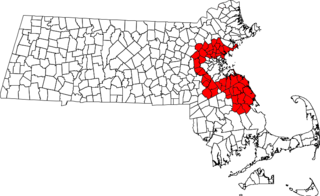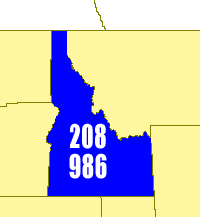
A bridge is a fixed dental restoration used to replace one or more missing teeth by joining an artificial tooth definitively to adjacent teeth or dental implants.

A dental implant is a prosthesis that interfaces with the bone of the jaw or skull to support a dental prosthesis such as a crown, bridge, denture, or facial prosthesis or to act as an orthodontic anchor. The basis for modern dental implants is a biological process called osseointegration, in which materials such as titanium or zirconia form an intimate bond to the bone. The implant fixture is first placed so that it is likely to osseointegrate, then a dental prosthetic is added. A variable amount of healing time is required for osseointegration before either the dental prosthetic is attached to the implant or an abutment is placed which will hold a dental prosthetic/crown.

Area code 781 and 339 are telephone area codes in the North American Numbering Plan for the U.S. state of Massachusetts. The numbering plan area consists of Boston’s inner suburbs, known as the Route 128 corridor, and some outer suburbs, especially in the South Shore region. It was created as in an area code split of area code 617 on September 1, 1997. Use of 781 became mandatory February 1, 1998. Area code 339 is an overlay complex code for the same service area, activated on May 2, 2001. Since then, ten-digit dialing has been mandatory.

Area codes 208 and 986 are telephone area codes in the North American Numbering Plan for all of Idaho. Area code 208 is one of the 86 original area codes created by the American Telephone and Telegraph Company in 1947. It was Idaho's sole area code until 2017, when 986 was added as a second area code to the same numbering plan area by creating an overlay complex.

Area codes 617 and 857 are telephone area codes in the North American Numbering Plan (NANP) for the U.S. state of Massachusetts, serving the city of Boston and several surrounding communities such as Brookline, Cambridge, Newton and Quincy. Area code 617 is one of the original North American area codes created in October 1947, when it served the eastern two-thirds of Massachusetts, from roughly the western end of Worcester County to Cape Cod and the South Coast.
A dental emergency is an issue involving the teeth and supporting tissues that are of high importance to be treated by the relevant professional. Dental emergencies do not always involve pain, although this is a common signal that something needs to be looked at. Pain can originate from the tooth, surrounding tissues or can have the sensation of originating in the teeth but be caused by an independent source. Depending on the type of pain experienced an experienced clinician can determine the likely cause and can treat the issue as each tissue type gives different messages in a dental emergency.
Anodontia is a rare genetic disorder characterized by the congenital absence of all primary or permanent teeth. It is divided into two subsections, complete absence of teeth or only some absence of teeth. It is associated with the group of skin and nerve syndromes called the ectodermal dysplasias. Anodontia is usually part of a syndrome and seldom occurs as an isolated entity. There is usually no exact cause for anodontia. The defect results in the dental lamina obstruction during embryogenesis due to local, systemic and genetic factors.

Area code 802 is a telephone area code in the North American Numbering Plan (NANP) for the U.S. State of Vermont. AT&T established the numbering plan area (NPA) for the entire state with one of the original area codes in October 1947 and it remains Vermont's only area code.

Area code 605 is the telephone area code in the North American Numbering Plan for the entire U.S. state of South Dakota. The numbering plan area was designated in 1947, when the American Telephone and Telegraph Company (AT&T) devised a comprehensive telephone numbering plan for the United States and Canada.
This page is based on this
Wikipedia article Text is available under the
CC BY-SA 4.0 license; additional terms may apply.
Images, videos and audio are available under their respective licenses.






